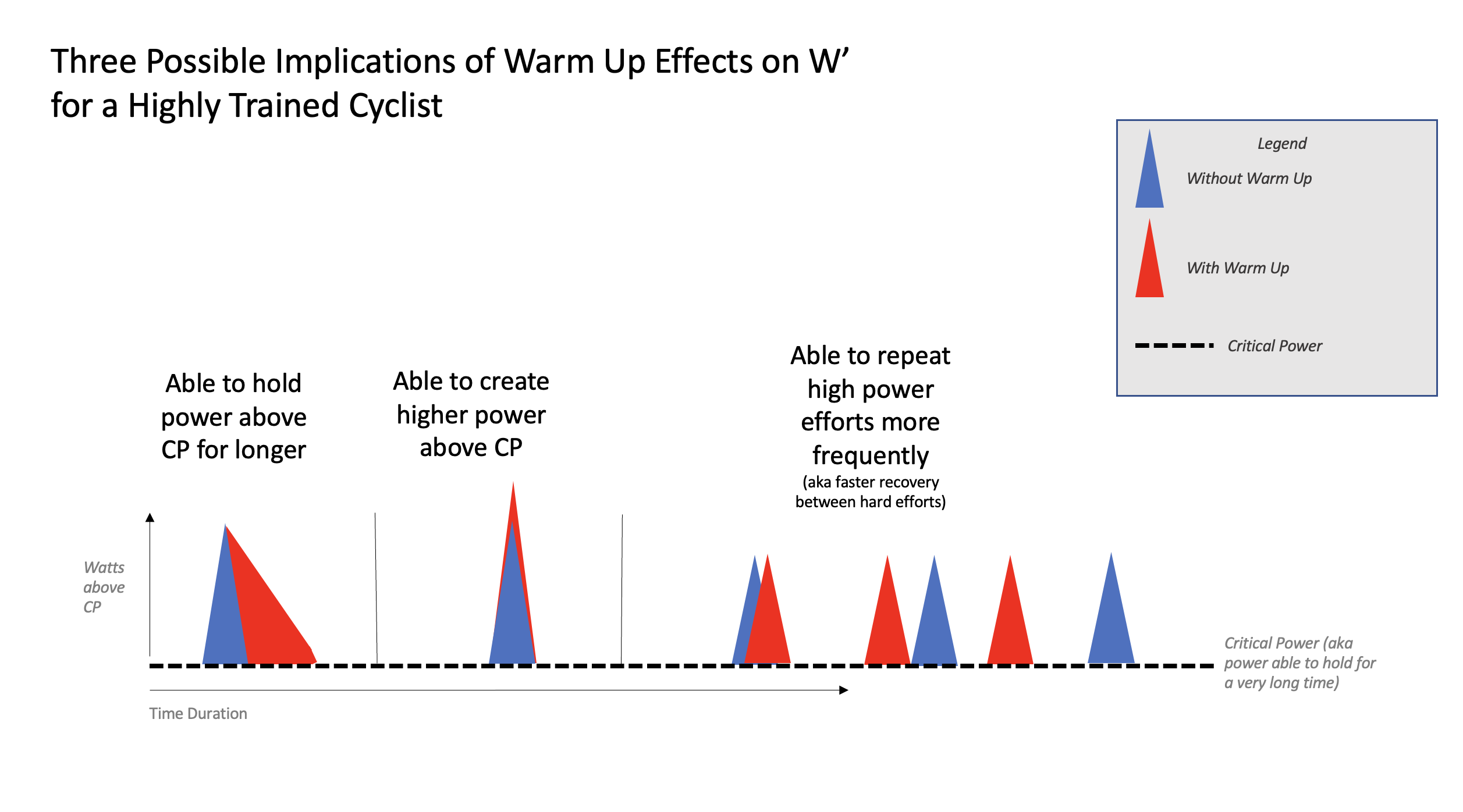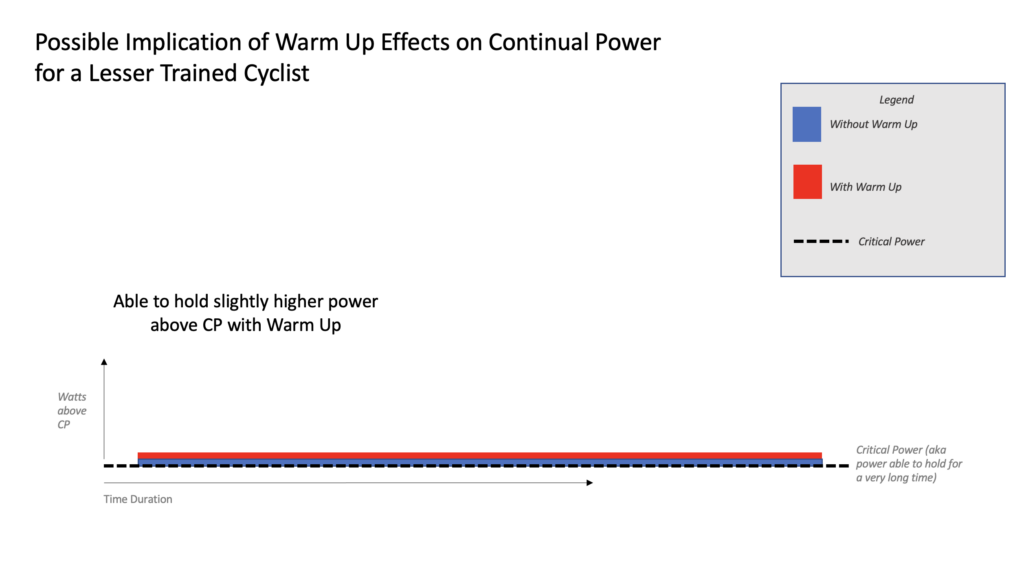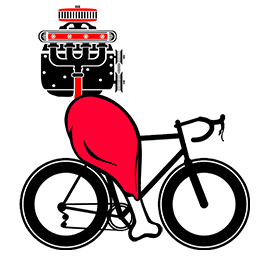How You Warm Up, and the Effect It Has Can Differ Based on your τVO2 and Event Duration
Recent studies show that doing an active “warm-up” before an endurance event may improve how you perform. Scientists call this the “priming effect.” A warm-up changes how fast your body adapts its oxygen use when you start exercising, which impacts how long you can last.
What is τVO2?
Your oxygen uptake kinetics measure how quickly your oxygen intake increases when you begin exercising. Slower oxygen uptake kinetics means your oxygen needs take longer to match your activity level. A “VO2 time constant” or τVO2 is how long this adjustment takes. A lower τVO2 means your oxygen use adapts more quickly to your effort so that you can perform better. A higher τVO2 means your oxygen use adapts more slowly to your effort, which worsens performance. Typically, the more you train, the lower/faster your τVO2.
How Warming Up Primes Your τVO2
A warm-up often lowers your τVO2, speeding up how fast your body meets its oxygen needs. It may also increase your “fundamental” oxygen intake or decrease your “slow component” – extra oxygen needed for some activities. These changes allow you to work at higher intensities for longer.
A warm-up’s effects depend on your fitness and event time. Highly fit athletes, with a τVO2 under 25 seconds, likely won’t see a reduced τVO2 from a warm-up but may enhance their “W-prime” – a fixed amount of work doable above a threshold. This could help in 2-30 minute events when some or critical parts of the race are above an “anaerobic threshold.” For less fit athletes with a slower τVO2, a warm-up may raise the “critical power” you can sustain, helping in events over 30 minutes.
Your τVO2 relates to your VO2max, so warm-up effects depend on your race duration and fitness.
Less fit athletes may mainly increase critical power; for highly fit athletes, a warm-up may predominantly increase W-prime, benefiting shorter/higher intensity events.
The Warm-Up Effect Based on Distinction in Event Type
This research review found that the effects of a priming warm-up on endurance performance seem to differ based on the duration of the event. Specifically:
Shorter Endurance Events (Less Than 30 Minutes)
For shorter endurance events (2-30 minutes), highly fit athletes with fast oxygen uptake kinetics (τVO2 < 25 sec) may predominantly benefit from the warm-up enhancing their W-prime. W-prime represents a fixed amount of work that can be performed above the aerobic threshold, so improving W-prime would allow these athletes to do more work at higher intensities during events of this duration. However, a warm-up may not substantially lower their already rapid τVO2.
The effect of W' on performance
The effect can be explained in various ways: High-intensity efforts: W' affects the ability to perform short, high-intensity efforts during a race or workout. Athletes with a larger W' can perform more work above their critical power before fatigue sets in, enabling them to maintain a higher pace or complete more intense intervals. Recovery between efforts: W' also plays a role in the recovery process between high-intensity efforts. The faster an athlete can replenish their W' during recovery periods, the more effectively they can perform subsequent high-intensity efforts. Pacing strategy: Understanding an individual's W' and critical power can help in determining optimal pacing strategies for endurance events. For instance, an athlete can use their W' to gauge how much they can push above their critical power during critical moments in a race without risking premature exhaustion. Training and adaptation: Monitoring changes in W' over time can provide insights into an athlete's training adaptations and inform adjustments in their training program to improve performance. In summary, W' affects performance by influencing an athlete's capacity for high-intensity efforts, recovery between efforts, pacing strategy, and training adaptations. Athletes with a larger W' have a greater ability to perform and recover from high-intensity efforts, which can lead to better overall performance in endurance events.
Longer Endurance Events (More Than 30 Minutes)
For longer endurance events (30+ minutes), less fit athletes or those with slower τVO2 are more likely to experience reductions in τVO2 from a warm-up. Remember that lowering τVO2 is a good thing because it means your aerobic response to the effort happens faster (with less lag.) This may lead to increases in their critical power. Critical power is the power that can be sustained for a long duration. (If you are new to the concept of CP, it is akin to the well know term FTP, though it is calculated in a slightly different manner.) Enhancing critical power would enable these athletes to maintain a higher effort for longer periods, benefiting endurance performance. Changes to W-prime may be less impactful for events of this duration unless there is a key break or surges in the race effort.
The Warm Up Effect Based on Distinction in Athlete Type
It is interesting to note that warming up assists an endurance athlete’s performance in two different ways, depending on the athlete’s fitness.
The More Fit Athlete
For a fit athlete with a faster τVO2 response, a warm-up appears to increase the W prime or repeated spikey power efforts well above CP or FTP.

The Less Fit Athlete
For a less fit athlete with a slower τVO2 response, a warm-up appears to increase the CP power for slightly higher, steadier power efforts just above CP (or FTP).

No One Size Fits All Warm-Up (Yet)
The best warm-up differs for different events and different athletes. Warm-up protocols that seek to improve W-prime for some athletes could reduce critical power for others. More study is needed to determine the best warm-up for maximum benefits.
It appears from this study that high-fitness athletes will benefit most from a warm-up for a short or very stochastic race (varied pace with lots of surges). These high-fitness endurance athletes benefit somewhat less from a warm-up for a long, steady race than a less fit athlete does.
While a warm-up may provide benefits through these mechanisms, significant research gaps remain regarding definitive recommendations based on event distance or athlete ability. The studies in this review did not determine precise warm-up methods based on standardized fitness measures. So athletes should interpret these theories cautiously until more conclusive evidence is available on tailoring warm-up strategies to event-specific needs.
Abstract
How Priming Exercise Affects Oxygen Uptake Kinetics: From Underpinning Mechanisms to Endurance Performance
The observation that prior heavy or severe-intensity exercise speeds overall oxygen uptake (𝑉O2) kinetics, termed the “priming effect”, has garnered significant research attention and its underpinning mechanisms have been hotly debated. In the first part of this review, the evidence for and against (1) lactic acidosis, (2) increased muscle temperature, (3) O2 delivery, (4) altered motor unit recruitment patterns and (5) enhanced intracellular O2 utilization in underpinning the priming effect is discussed. Lactic acidosis and increased muscle temperature are most likely not key determinants of the priming effect. Whilst priming increases muscle O2 delivery, many studies have demonstrated that an increased muscle O2 delivery is not a prerequisite for the priming effect. Motor unit recruitment patterns are altered by prior exercise, and these alterations are consistent with some of the observed changes in 𝑉O2 kinetics in humans. Enhancements in intracellular O2 utilisation likely play a central role in mediating the priming effect, probably related to elevated mitochondrial calcium levels and parallel activation of mitochondrial enzymes at the onset of the second bout. In the latter portion of the review, the implications of priming on the parameters of the power–duration relationship are discussed. The effect of priming on subsequent endurance performance depends critically upon which phases of the 𝑉O2 response are altered. A reduced 𝑉O2 slow component or increased fundamental phase amplitude tend to increase the work performable above critical power (i.e. W´), whereas a reduction in the fundamental phase time constant following priming results in an increased critical power.
Key Points
| A prior bout of heavy-intensity exercise speeds pulmonary oxygen uptake kinetics during subsequent exercise; however, the physiological mechanisms underpinning this effect have been the subject of great debate. |
| We critically evaluate the literature from the past 25 years, and conclude that this effect is primarily mediated by enhanced intracellular oxygen utilization and altered motor unit recruitment patterns. |
| We further provide recommendations for the role of priming exercise in enhancing endurance performance. |
Goulding, R.P., Burnley, M. & Wüst, R.C.I.
Sports Med 53, 959–976 (2023). https://doi.org/10.1007/s40279-023-01832-1
Listen to the Two Minute Audio Summary

Jordan Fowler has experience as a head swimming coach of the Frisco Swim Team, a TAAF-awarded coach, a track and field distance running consultant for select Texas High School runners, and has competed as a triathlete, road runner, and cyclist. Though he is remarkably slower than he was in his 20s and 30s, he still enjoys endurance sports and sports science studies.
